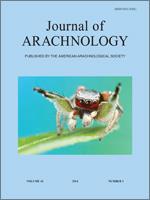The burrow structure and microhabitat variables of the little known theraphosid Nesiergus insulanus Simon 1903 were determined on Frégate Island, Seychelles. The species constructed burrows in fossorial substrates, including rocks, leaf litter and bare soil as well as on the trunks of decaying trees, both recumbent and standing. The majority of burrows were predominantly found in sandy loam soil with partial protection from the sun. The density of burrows was determined to be weakly positively correlated to soil and substrate type and strongly negatively correlated to degree of exposure to the sun. The pH of the soil in which burrows are found was not significantly related to burrow sites, and variability in burrow structure was revealed. Burrow aggregations vary from single burrows to aggregations exceeding 100, distributed randomly.
BioOne.org will be down briefly for maintenance on 14 May 2025 between 18:00-22:00 Pacific Time US. We apologize for any inconvenience.
How to translate text using browser tools
1 November 2014
Burrow structure and microhabitat characteristics of Nesiergus insulanus (Araneae: Theraphosidae) from Frégate Island, Seychelles
Gregory Canning,
Brian K. Reilly,
Ansie S. Dippenaar-Schoeman
ACCESS THE FULL ARTICLE

The Journal of Arachnology
Vol. 42 • No. 3
November 2014
Vol. 42 • No. 3
November 2014
generalist
habitat
tarantula




